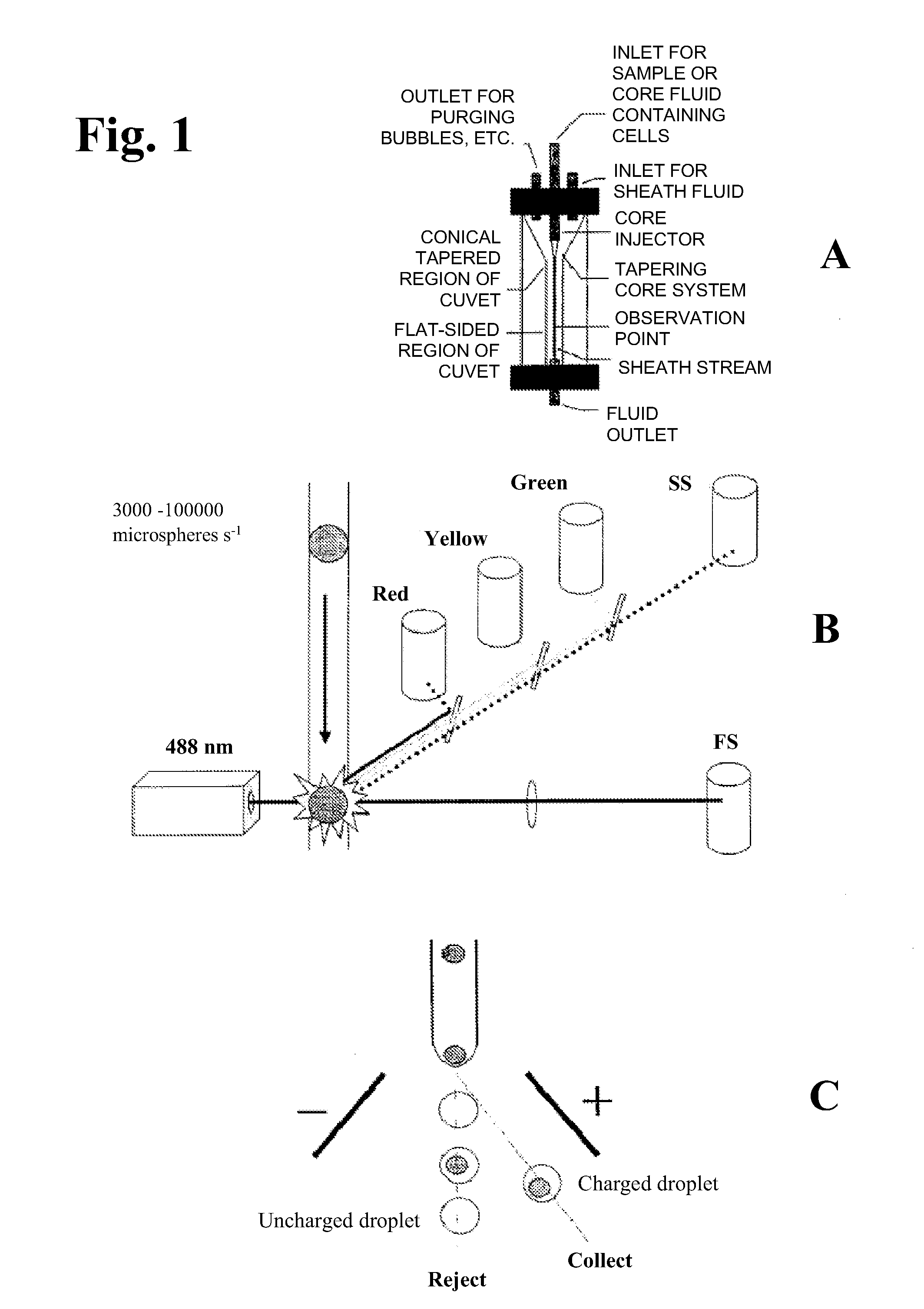Carriers for combinatorial compound libraries
a carrier and compound library technology, applied in chemical libraries, combinational chemistry, peptide preparation methods, etc., can solve the problems of intractable problems, special difficulty in the “deconvolution” procedure, and difficulty in the split synthesis technology referred to abov
- Summary
- Abstract
- Description
- Claims
- Application Information
AI Technical Summary
Benefits of technology
Problems solved by technology
Method used
Image
Examples
example 1
Summary of a Flow Cytometric Determination of Combinatorial Reaction Histories According to the Invention
[0170]A split-process-recombine procedure involving m steps, say step 1, step 2, . . . , step m, and n(i) processes at step i (i=1,2, . . . , m) may be defined as follows. For i=1,2, . . . , m, let the n(i) processes at step i be P1(i),P2(i), . . . , Pn(i)(i). At each step i=1,2, . . . , m:
[0171]the carriers are partitioned, at random but possibly in specific ratios, into n(i) subsets S1(i),S2(i), . . . , Sn(i)(i);
[0172]for j=1,2, . . . , n(i) process Pj(i) is performed on the carriers in subset Sj(i);
[0173]the carriers are recombined.
[0174]A schematic representation of this procedure is shown in FIGS. 2 and 3.
[0175]Examples of such processes include the combinatorial synthesis of oligonucleotide and oligopeptide chains. In these examples, insoluble polymer beads (colloidal particles, typically 1-1000 μm in diameter) may be used as the carriers onto which nucleic or amino acid mo...
example 2
Encoding Strategy
Optically Unique Microspheres
[0180]To positively identify a given microsphere in a population by measurement of its optical properties requires that the given microsphere has a set of optical properties that is unique from every other microsphere in the population. For two microspheres to be optically different, they need only differ in one of their optical properties. That is, all of their respective optical properties could be identical except for one distinguishable difference.
[0181]When a flow cytometer measures each optical property or parameter, the electrical current output from the corresponding photomultiplier tube is converted to a relative value or channel number, which is an integer value between 0 and 1023 for an instrument operating in linear mode at a resolution of 1024. Therefore, using only one optical property, e.g., light scattering intensity at 90°, the maximum possible number of unique microspheres would be 1024.
[0182]If an additional optical pr...
example 3
Silica Microspheres
Introduction
[0205]Silica microspheres or particles have been well studied as model colloidal particles by the work of Iler (Iler R K, 1979, “The chemistry of silica: solubility, polymerization, colloid and surface properties, and biochemistry”. New York, John Wiley & Sons) and others (Bergna H E, 1994, “The colloid chemistry of silica”. Washington D.C., American Chemical Society). Early synthetic processes prepared a colloidal sol of silica by passing a dilute solution of sodium silicate through a bed of hydrogen ion-exchange resin and then raising the pH to 8-9 with addition of alkali. Stable sols of 10 to 130 nm in diameter could be prepared using this process by heating a portion of this solution to 100° C. and slowly adding the remaining portion of the solution as the heated portion became more concentrated through evaporation. As the particles in the heated portion (4-6 nm) were larger than the particles in the remainder of the solution (2-3 nm), all of the s...
PUM
| Property | Measurement | Unit |
|---|---|---|
| Volume | aaaaa | aaaaa |
| Volume | aaaaa | aaaaa |
| Volume | aaaaa | aaaaa |
Abstract
Description
Claims
Application Information
 Login to View More
Login to View More - R&D
- Intellectual Property
- Life Sciences
- Materials
- Tech Scout
- Unparalleled Data Quality
- Higher Quality Content
- 60% Fewer Hallucinations
Browse by: Latest US Patents, China's latest patents, Technical Efficacy Thesaurus, Application Domain, Technology Topic, Popular Technical Reports.
© 2025 PatSnap. All rights reserved.Legal|Privacy policy|Modern Slavery Act Transparency Statement|Sitemap|About US| Contact US: help@patsnap.com



